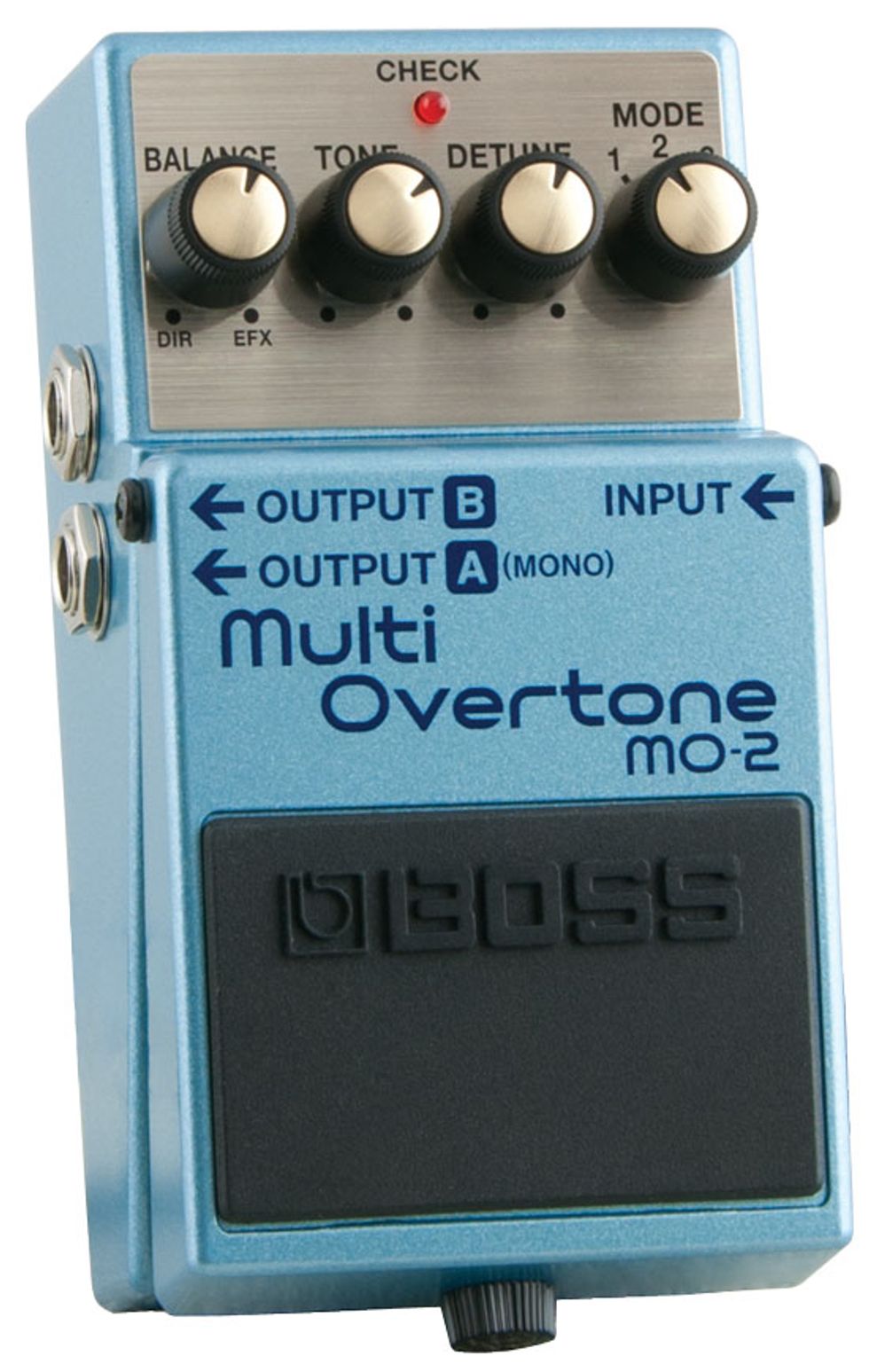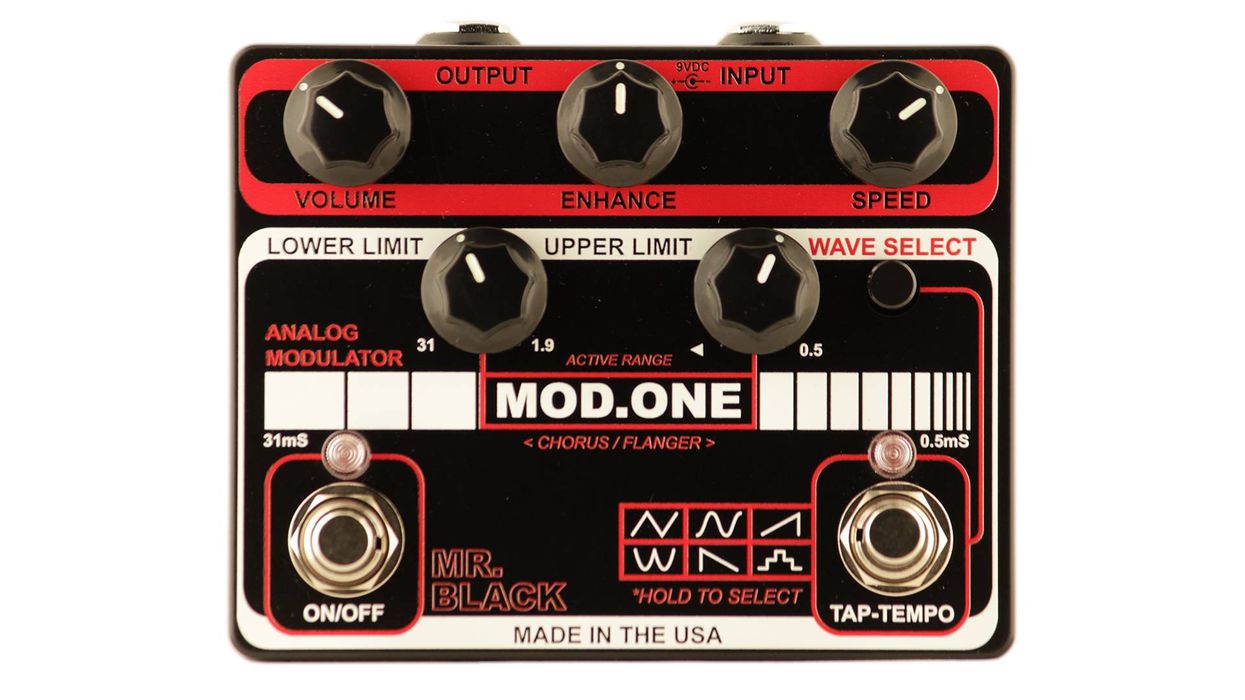Though it’s rarely a heavily employed effect, octave manipulation has enjoyed a resurgence in popularity over the last decade or so. For many, the immediate musical association with the effect is the deeper, darker facets of the metal genre. But octave effects can be effective in almost any guitar setting. When used with discretion, throwing in a sub octave or detuning a higher frequency can add a nice texture—an unexpected twist on an otherwise standard chord structure or lead. And when used less subtly, octave effects can define a whole tune and totally recast an otherwise ordinary guitar part.
Over the years, Boss has released several octave effects. The newest addition—the MO-2 Multi-Overtone—uses the company’s multi-dimensional processing (MDP) to create not just your average octave pedal, but a pitch-shifting unit that can accentuate high, low, or midrange octaves with a unique harmonized charm.
Boss Basics
The MO-2 Multi-Overtone is housed in the same box as all of its illustrious predecessors. And, like just about every Boss pedal that’s come before it, this thing will likely withstand stage use and abuse for many years without complaint. A 9V battery fits under the footpad, but a standard barrel adapter connects at the crown of the unit. At the top of the sparkled, sky-blue box are four controls that harness and manipulate the output—balance, tone, detune, and mode.
Balance adjusts the wet/dry ratio of your effected output. A fully counterclockwise turn leaves your signal completely dry. Maxing the control saturates your output, with little perceptible dry signal. The tone control colors the effect with a greater bass or treble response, with a balanced, neutral flavor around noon.
The mode knob switches between three settings that deliver different levels of overtone. Rather than selecting specific intervals (such as thirds, fifths, or sevenths) like a harmonizer, the MO-2 targets broader frequencies. Mode 1 accentuates higher frequencies, mode 2 takes the middle road, and mode 3 enhances low end along the lines of a sub-octave pedal.
The detune knob essentially pitch-shifts part of your output, and you’ll notice slightly different performance characteristics, depending on the mode you’ve selected. In mode 1, an increased detune thickens up your entire guitar signal. In mode 2, detune brings out more of a Leslie-like warble, and increasing detune in mode 3 infuses a chorus-like effect—albeit one that’s a little on the darker side of the tonal spectrum. There’s no speed knob to control the detuned swirl, but the speed of the effect seems to increase the more you twist detune clockwise, with a somewhat chaotic feel coming in at higher settings.
Pick a Frequency
Setting up a ’68 Fender Bassman for an essentially clean output, I paired the MO-2 with a Les Paul and started exploring mode 1. Increasing the tone and maxing detune get me pretty close to Jonny Greenwood’s intro lead on Radiohead’s “My Iron Lung,” but with less Whammy-style glitching. And the chord tracking is sharp and accurate enough to deliver a pretty decent-sounding 12-string simulation when you dial back the detune knob. There’s a nice weight to open chords in these settings, too, although I found myself having to roll back the tone to tame some harsh trebles—a little below noon was the best setting for most chord work.
Ratings
Pros:
Multitude of cool rhythm and lead sounds. Tracks chords and leads equally well. Stereo output.
Cons:
No dedicated speed/rate control for the detune effect.
Tones:
Playability/Ease of Use:
Build/Design:
Value:
Street:
$129
Company
bossus.com
Mode 2 has a distinct organ-like quality that hums with harmonic gusto when all controls are set to noon. Adding a bit of reverb on top really rounded out the weight of full chords, but when I kept things dry the texture was actually quite effective for adding singing, organ-meets-cello overtones to neoclassical shredding. The single-coils of a Fender Telecaster added a nice sting to bombastic double-note pull-offs, coaxing tones that evoke frenzied Atomic Rooster riffage when you dial in a swirling detune setting. Turning up the Bassman to break-up levels increased this Deep Purple-style, organ-flavored output, although even in these seemingly meaty tone environs you have to roll off the tone when increasing balance to tame the biting high-end that the MO-2 generates.
The lowest octave tones are there for the taking in mode 3, which generates tones a full octave below the fretted note. Rolling off the tone and nixing the detune function makes rhythm chords enormous, not unlike the output you’d get from a chorused baritone guitar. Maxing the detune knob at these settings adds layers of chime to create a slithering, lush experience for chord structures built around open strings. Volume swells in this setup have a choir-like vocal quality and get dramatically more synth-like when you turn up the balance—a very cool effect. I also generated some very cool saturation for leads with all the settings at noon, and with a touch of amp gain the sound turned into a smooth, robotic croon. For heavier riffs, be sure to place your distortion box before the MO-2, otherwise you’ll lose some definition.
The Verdict
It’s a little difficult to categorize the Boss MO-2 Multi-Overtone pedal. Is it an octave pedal? A harmonizer? A modulator? In reality, it’s a bit of each, and the parameters are adjustable and flexible enough to accentuate and blend each of the effects or to enhance their individual voices, which makes the MO-2 a very dynamic pedal.
With a $129 street price, the MO-2 sits in the pricier end of Boss’ compact-pedal line, but it’s a lot cheaper than some of the comparable competition—and you get a lot of sounds that can be molded to rhythm or lead play. If you’re itching to blend some overtones and new textures into your rig and want to avoid some of the larger contraptions, this Boss is a little saddlebag of octave effects overflowing with harmonizing tricks.








![Rig Rundown: Russian Circles’ Mike Sullivan [2025]](https://www.premierguitar.com/media-library/youtube.jpg?id=62303631&width=1245&height=700&quality=70&coordinates=0%2C0%2C0%2C0)


























